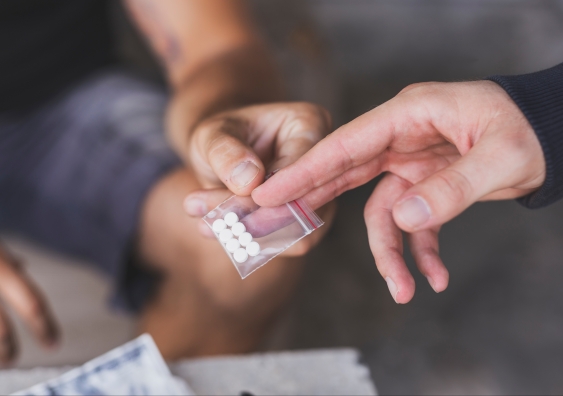Governments in Australia spent nearly $5.5 billion on illicit drug countermeasures in 2021/2022, but less than 10 per cent went towards strategies aimed at preventing use and reducing negative consequences.
Australian governments spend more on law enforcement in illicit drug policy than treatment, prevention and harm reduction combined, says a 䧣´üçêÅ Sydney report.
The findings published todayô reveal that state and federal governments spent approximately $5.45 billion in the 2021/2022 financial yearô on illicit drug countermeasures.ô Nearly 65ô per centô ($3.5 billion) was spentô on law enforcement programs, including $1.8 billion on routine policing against drugs.ô Less than 2ô per centô ($90 million) was spentô on harm reduction measures such as needle syringe programs and supervised injectingô facilities.
ãGovernments do invest a significant amount of money on proactive drug policy, andô where they spend that money shows what they consider as important in responding to drugs,ãô saysô ô AO, theô reportãsô lead author and drug policy specialistô at theô Social Policy Research Centre,ä»ä§£´üçêÅ Arts, Design & Architecture.ô ãThis research provides the foundation for evaluating the investment and whether Australia is on the right path to reducing drug-related harm.ã
Media enquiries
For enquiries about this story and interview requests, please contactô Ben Knight, News & Content Coordinator, 䧣´üçêÅ Arts, Design & Architecture.
Ýò°µÇúýåÝÞ:ä»(02) 9065 4915
ñÀ°ƒý¿ƒÝݶ:ä»b.knight@unsw.edu.au
Proportion of spending down on prevention and harm reduction
Theô Australian ãdrug budgetã:ô Governmentô drug policy expenditureô 2021/22ô is the most recent report in theô ãdrug budgetãô series, whichô estimatesô spending onô proactive responses to illicitô drugs by governments across Australia.
The proportion spent on prevention, such as in-school education programs, slightly decreased since the last report in 2009/10, down from 9.5ô per cent to 6.7 per centô in 2021/22. Spending on harm reduction also decreased from 2.2ô per centô to just 1.6ô per cent.
Spending on law enforcement remained relatively stable, slightly down from 64.9 per cent to 64.3 per cent of expenditure. Meanwhile, spending on drug treatment services rose from 22.0ô per cent to 27.4 per cent.
Dr Annie Madden AO, Executive Director of Harm Reduction Australia (HRA), says the report reveals the true extent of governmentsã chronic under-investment in harm reduction.
ãAustralian governments have continued to claim their position as a global leader in harm reduction over many decades. In this case, however, the evidence does not lie,ã Dr Madden says. ãWe know that frontline harm reduction services such as needle and syringe programs, opioid treatment, take-home naloxone, drug consumption rooms and drug checking services reduce potential harms including drug-related deaths.
ãThe fact that harm reduction spending has continued to decline in the face of unprecedented evidence of impact and effectiveness is deeply concerning for many reasons, not the least of which is the undeniable fact that harm reduction saves lives.ã
State and territory governments spent the most against illicit drugs, accounting for 76 per cent or $4.11 billion of the total proactive expenditure, the majority of which ($2.87 billion) was for state law enforcement.ô
ãTheô lionãsô share of the investment is from state governments and continues to be in law enforcement, andô thatãsô related to the policing of drugs, which we know is an expensive activity,ãô Prof. Ritter says.ô ãAt the same time, the amountô thatãsô invested in helping people who are experiencing problems with illicit drugs is significantly less as a proportion of spending.ã
Illicit drug use is a significant health, social and economicô issue for Australia, with the latestô ô population survey showing a small increase last year in use, Prof. Ritter says. Thereô hasô also beenô a noticeableô shift in the types of illicit drugsô being used, includingô crystal methamphetamine and hallucinogens.
CEO of Alcohol and Drug Foundation, Dr Erin Lalor AM, says despiteã₤efforts from law enforcement, thereãs been a concerning increase in the number of Australians experiencing drug-related harms, such as hospitalisations and fatal overdoses. She says prevention is a crucial part of a comprehensive approach needed to reduce the impact of drug-related harms, particularly among young people.ã₤
ãThe number of drug-induced deaths in Australia is unacceptably high and has sadly been increasing since 2006,ã Dr Lalor says. ãThese heartbreaking deaths are mostly preventable andô have a ripple effect on the community, with friends and families suffering.
ãWe need increased, long-term funding commitments for evidence-based prevention initiatives that reduce risk factors for harmful illicit drug use and boost protective factors, as well as targeted education campaigns in populations at greater risk of harm and those that address stigma.ã
While the total amount spent by governments against illicit drugs more than tripled from the last report in 2009/10 ($1.7 billion), the 2021/2022 estimate represents just 0.63ô per centô of all government spending, down from 0.80ô per cent in the last report.
ãThese figures suggest that despite a significant increase in proactive government spending on drugs since the last report, this reflects overall growth in government spending and not growth in spending on drug countermeasures,ãô Prof. Ritter says.ô ãHowever,ä»whatãsô striking is that despite the percentage reduction in proactive expenditure, thereô hasnãtô been any significant shift in the proportion of investment amongst the four domains of drug policy.ã
Most people, on average, want governments to spend equal amounts on policing, treatment and prevention.
Impact on service providers
The Network of Alcohol andô otherô Drugs Agencies (NADA) is the peak body for NGO AOD service providers in NSW. Its CEO, Dr Robert Stirling, says services on the frontline are suffering from the lack ofô growth in investment
ãWe have a noticeable, growing unmet demand for services in the sector from underfunding, demonstrated by increasing wait times for treatment and workforce shortages from a lack of secure working conditions,ã Dr Stirling says.ô
ãAt the NSW level, money for treatment has predominantly been spent on new services rather than investing in existing services to ensure they can deliver quality services and create healthy workplaces and conditions.ô
ãMeanwhile, at the Commonwealth level, funding has been going backwards, leaving services struggling to retain staff and needing to reduce services to communities.ã
Emma Maiden, General Manager of Advocacy and External Relations for Uniting NSW.ACT, says governments should consider removing criminalô penalties,ä»and redirect funding towards the other pillars of drug policy.ô
ãTo see that the largest expenditure in the latest Australian ãdrug budgetã is once again directed to law enforcement, and how that spending monsters whatô is spentô on drug treatment, prevention and harm reduction programs, is of great concern,ã Ms Maiden says. ãWe need our governments to have the courage to take action and invest the lionãs share of our drug budget in the things we know will make a difference.ã
Prof. Ritter says theô reportô does not assess the effectiveness of the investment across domains, and the relative value of the estimates is more important than any absolute value.ô
ãThere is no line item in government expenditure estimates that explicitly lays out how much they spend on illicit drugs,ãô Prof. Ritter says.ô ãSo, there are some assumptions behind every figure, which we have accounted for in our sensitivity analysis.ã
The latestô National Drug Strategy Household Survey alsoô shows Australians want roughly equal investment across education, treatment, and law enforcement in illicit drug policy.
ãMost people, on average, want governments to spend equal amounts on policing, treatment and prevention,ãô Prof. Ritter says.ô ãSo, the current investment mix does not necessarily match how most Australians would prefer governments to allocate funding across the domains of drug policy.ã
Related stories
-

Evidence of injecting drug use found in 190 countries: global review
-

New study finds large increase in cocaine-related deaths in Australia over the last decade
-

Almost half of people who regularly consume ecstasy have tested their drugs: NDARC report
-

ãThereãs no reason not to trial pill testingã: 䧣´üçêÅ drug policy scholar stands firm on the evidence





